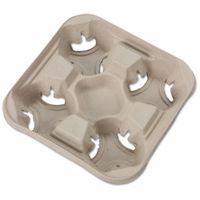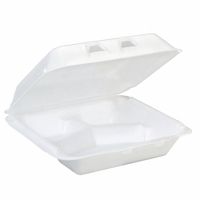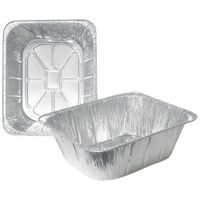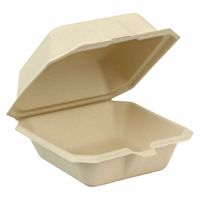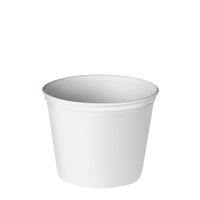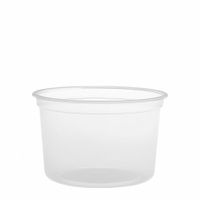Call +(254) 703 030 000 / 751 483 999 / 721 704 777
- Home
- Furnishings Appliances Hospitality
- Breakroom Food Service Disposables
- Disposable Carry Out Containers Lids
Frequently Asked Questions
What are the benefits of using foam carry-out containers?
Foam carry-out containers offer several benefits that make them a popular choice for food service businesses. Firstly, they provide excellent insulation, keeping hot foods hot and cold foods cold for extended periods. This temperature retention is crucial for maintaining food quality and safety during transport. Secondly, foam containers are lightweight, which reduces shipping costs and makes them easy for customers to carry. Their lightweight nature also contributes to lower fuel consumption during transportation, offering an environmental advantage in terms of reduced carbon emissions.
Additionally, foam containers are cost-effective. They are generally cheaper to produce than alternatives like paper or biodegradable containers, allowing businesses to save on packaging costs. This affordability makes them an attractive option for restaurants and food vendors operating on tight budgets.
Foam containers are also durable and resistant to leaks, which helps prevent spills and maintains the integrity of the food. This durability ensures that the containers can withstand the rigors of transport without breaking or collapsing. Furthermore, foam containers are versatile and can be used for a wide range of food items, from soups and stews to salads and sandwiches.
Another benefit is that foam containers are easy to stack and store, optimizing space in storage areas and making them convenient for both businesses and consumers. Lastly, foam containers can be customized with branding, logos, or other designs, providing businesses with an opportunity to enhance their brand visibility and marketing efforts.
Overall, the benefits of foam carry-out containers include excellent insulation, cost-effectiveness, durability, versatility, and the potential for branding, making them a practical choice for many food service operations.
How do paper carry-out containers help reduce environmental impact?
Paper carry-out containers help reduce environmental impact in several ways. Firstly, they are typically made from renewable resources, such as wood pulp, which can be sustainably sourced from managed forests. This contrasts with plastic containers, which are derived from fossil fuels, a non-renewable resource.
Secondly, paper containers are biodegradable and compostable, meaning they break down naturally in the environment without leaving harmful residues. This reduces the accumulation of waste in landfills and minimizes pollution. In contrast, plastic containers can take hundreds of years to decompose and often contribute to microplastic pollution in oceans and waterways.
Additionally, paper containers are often recyclable. When properly disposed of, they can be processed and reused to create new paper products, thus reducing the demand for virgin materials and conserving natural resources. This recycling process also typically requires less energy compared to producing new plastic products, further decreasing the carbon footprint.
Moreover, advancements in technology have led to the development of paper containers with water and grease-resistant coatings that are still environmentally friendly. These innovations ensure that paper containers can effectively replace plastic ones in a variety of food service applications without compromising functionality.
Finally, the use of paper carry-out containers can encourage businesses and consumers to adopt more sustainable practices. As awareness of environmental issues grows, the demand for eco-friendly packaging options increases, prompting more companies to invest in sustainable solutions and contribute to a circular economy.
In summary, paper carry-out containers offer a more sustainable alternative to plastic by being renewable, biodegradable, recyclable, and encouraging environmentally conscious behavior.
What materials are molded fiber carry-out containers made from?
Molded fiber carry-out containers are primarily made from recycled paper products. These materials typically include:
1. **Recycled Paper**: The primary component is post-consumer recycled paper, such as old newspapers, office paper, and cardboard. This helps in reducing waste and promoting sustainability.
2. **Wood Pulp**: Some containers are made from virgin wood pulp, which is derived from softwood or hardwood trees. This pulp is processed to create a fibrous material suitable for molding.
3. **Bagasse**: This is a byproduct of sugarcane processing. After the juice is extracted from sugarcane, the remaining fibrous material, bagasse, is used to make molded fiber products. It is biodegradable and compostable.
4. **Bamboo Pulp**: Bamboo is a fast-growing, renewable resource. Bamboo pulp is used in some molded fiber products due to its strength and eco-friendly properties.
5. **Wheat Straw**: This is an agricultural byproduct from wheat production. Wheat straw pulp is used as an alternative to wood pulp, offering a sustainable option for molded fiber products.
6. **Other Plant Fibers**: Occasionally, other plant fibers like kenaf, jute, or hemp may be used, depending on availability and desired product characteristics.
These materials are processed into a slurry, which is then molded into the desired shape using heat and pressure. The resulting products are biodegradable, compostable, and often used as an eco-friendly alternative to plastic or Styrofoam containers.
Are plastic carry-out containers more durable than other types?
Plastic carry-out containers are generally more durable than many other types of containers, such as paper or cardboard, due to their inherent material properties. Plastics like polypropylene and polyethylene are resistant to moisture, oils, and chemicals, which makes them ideal for holding a variety of foods without degrading. They are less likely to tear or become soggy compared to paper-based containers, especially when holding liquid or greasy foods.
Plastic containers are also more resistant to physical damage. They can withstand drops and impacts better than glass or some biodegradable materials, which can crack or shatter. This durability makes them suitable for repeated use, although they are often designed for single-use in the context of carry-out food.
However, the durability of plastic containers comes with environmental trade-offs. They are not biodegradable and can persist in the environment for hundreds of years if not properly recycled. This contrasts with biodegradable or compostable containers made from materials like bagasse or PLA (polylactic acid), which are designed to break down more quickly but may not offer the same level of durability or moisture resistance.
In summary, while plastic carry-out containers are more durable in terms of resistance to moisture, chemicals, and physical damage, they pose significant environmental challenges. Their durability in practical use is a double-edged sword, offering convenience and protection for food at the cost of long-term environmental impact.
How do foil carry-out containers help preserve food?
Foil carry-out containers help preserve food by providing an effective barrier against moisture, light, and air, which are key factors that can lead to food spoilage. The aluminum foil used in these containers is impermeable to moisture and gases, which helps maintain the food's original moisture content and prevents it from drying out. This is particularly important for foods that are prone to losing moisture, such as baked goods and cooked meats.
Additionally, foil containers reflect light and heat, which can help maintain the temperature of the food for a longer period. This is beneficial for both hot and cold foods, as it helps keep hot foods warm and cold foods cool, reducing the risk of bacterial growth that can occur when food is kept at unsafe temperatures.
The sturdy structure of foil containers also provides physical protection to the food, reducing the risk of damage during transport. This is especially useful for delicate foods that can be easily crushed or deformed.
Moreover, foil containers are often used with tight-fitting lids, which further enhance their ability to preserve food by creating a seal that minimizes exposure to air. This helps in retaining the food's flavor and aroma, as well as preventing the absorption of external odors.
In summary, foil carry-out containers preserve food by providing a barrier against environmental factors that cause spoilage, maintaining temperature, offering physical protection, and sealing in freshness and flavor.
What are the advantages of using beverage trays and carriers?
Beverage trays and carriers offer several advantages, enhancing both convenience and efficiency in various settings. Firstly, they provide ease of transport, allowing multiple drinks to be carried simultaneously, reducing the number of trips needed and saving time. This is particularly beneficial in busy environments like cafes, restaurants, and events where quick service is essential.
Secondly, they enhance safety by minimizing the risk of spills and accidents. Beverage trays and carriers are designed to securely hold drinks in place, preventing them from tipping over during transport. This not only protects the beverages but also reduces the likelihood of slips and falls caused by spilled liquids.
Thirdly, they contribute to better organization. With designated slots or compartments, these carriers keep drinks neatly arranged, making it easier to identify and distribute orders accurately. This is especially useful in settings with multiple orders or when serving a large group.
Additionally, beverage trays and carriers are often reusable and made from durable materials, promoting sustainability by reducing the need for single-use packaging. This aligns with environmentally conscious practices and can enhance a business's reputation among eco-friendly consumers.
Moreover, they can be customized with branding, serving as a marketing tool. Custom trays and carriers with logos or brand colors can increase brand visibility and recognition, providing a subtle yet effective form of advertising.
Finally, they improve customer satisfaction by ensuring that drinks arrive intact and at the desired temperature. Insulated carriers, for example, maintain the temperature of hot or cold beverages during transport, enhancing the overall customer experience.
In summary, beverage trays and carriers offer practical benefits such as convenience, safety, organization, sustainability, branding opportunities, and improved customer satisfaction, making them an essential tool in the food and beverage industry.
How do I choose the right type of carry-out container for my needs?
To choose the right type of carry-out container, consider the following factors:
1. **Material**:
- **Plastic**: Durable and leak-proof, ideal for liquids and hot foods. Look for BPA-free options.
- **Foam**: Good for insulation, keeping hot foods hot and cold foods cold, but not environmentally friendly.
- **Paper/Cardboard**: Eco-friendly and biodegradable, suitable for dry foods and short-term use.
- **Aluminum**: Excellent for heat retention and oven reheating, but not microwave-safe.
2. **Food Type**:
- **Hot Foods**: Use insulated or heat-retaining containers like foam or aluminum.
- **Cold Foods**: Plastic or paper containers work well.
- **Liquids/Soups**: Leak-proof plastic or sturdy paper containers with tight lids.
3. **Portion Size**:
- Choose containers that match the portion size to avoid waste and ensure proper presentation.
4. **Durability**:
- Consider the strength and sturdiness, especially for heavy or saucy foods.
5. **Environmental Impact**:
- Opt for biodegradable or recyclable materials to minimize environmental impact.
6. **Cost**:
- Balance quality with budget. Bulk purchasing can reduce costs.
7. **Branding**:
- Customizable containers can enhance brand visibility and customer experience.
8. **Regulations**:
- Ensure compliance with local health and safety regulations regarding food packaging.
9. **Convenience**:
- Look for features like stackability, easy sealing, and reheating capabilities.
10. **Customer Preference**:
- Consider customer feedback and preferences for sustainable or specific types of containers.
By evaluating these factors, you can select the most suitable carry-out container for your specific needs, ensuring food safety, quality, and customer satisfaction.
